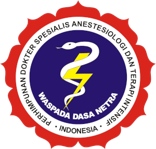Therapeutic Plasma Exchange in High Care Unit for Patient with a Snake bite : a Case Report
Abstract
Background : Snake bites are one of the commonest occupational hazards in tropical countries and viperine bites are potential to cause systemic toxicity. Hemolitik anemia, coagulopathies, and acute kidney injury (AKI) have been documented, main therapy on snake bite with antivenom, when it combine with plasmapheresis it shown promising result. This case reports highlight the effective use of plasmapheresis for snake bite therapy.
Case Illustration : A 40-year old presented following 7-days at HCU Dr Moewardi Hospital of snake bite with the right hand is swollen, blistered, painful, weakness, nausea, the yellowish body, icteric conjunctiva, and dark brown colored urin. A patient has anemia, leukocytosis, thrombocytopenia, increased total bilirubin, direct bilirubin, indirect bilirubin, elevate liver enzyme, and uremia. The patient was treated for 7 days in the HCU. Patient received 10 cc of antivenom in 500 cc 0,9% normal saline every 8 hours for 3 days. Patient also received one times therapeutic plasma exchange (TPE) on 2nd of admission, TPE with 2.500 ml output of plasma. The patient had received 8 flash 5% albumin therapy, with each flash contains 250 cc of 5% albumin and 1 flash 0,9% normal saline, with each flash contains 500 cc of 0,9% normal saline, with total liquid intake is 2500 cc. Patient with GCS E4V5M6.
Conclusion : Most patients with snake bite present with hemolitik anemia, coagulopathies, and acute kidney injury (AKI). The management of snake bite is mainly with antivenom. In addition plasmapheresis not only eliminate the venom circulating in the blood, would also eliminate the toxins diffused into extravascular spaces and target organs after redistribution phenomenon. Therefore, therapeutic plasma exchange should be utilized as part of a tailored treatment plan that considers the patient's overall clinical condition and needs. This case report a 40-year-old as show evidence for the effectiveness of plasmapheresis treatment.
Keywords
Full Text:
PDFReferences
1. Mohammad Abul Faiz, Taufiqui Islam, Nechen Dorji, Shiv Lal, Mradul Kumar Daga, Ajit Nair, et al. (2016). Guidelines For The Management Of Snake bites 2nd Edition. 2016; 1-208.
2. Elmoqaddem, A., Mrani Alaoui, N., Cherrad, T., Hmidi, M., Choumi, F., Nadour, K. (2020). Plasma Exchange in a Patient with a Severe Viper Bite. Saudi Journal of Medical and Pharmaceutical Sciences. 2021; 7(1): 50-51.
3. Pantanowitz, L., & Andrzejewski, C. (2016). Plasma exchange therapy for victims of envenomation: is this reasonable?. Journal of clinical apheresis. 21(4), 215-218.
4. Larreche, S., Mion, G., Clapson, P., Debien, B., Wybrecht, D., & Goyffon, M. (2018). Ophidian neurotoxins. Ann Fr Anesth Reanim. 27:310–316.
5. Faria R,Bucur A, Gordinho A, Falcao L, Carrao A, Fernandes S, et al. Therapeutic Plasmapheresis: Seven Year Experience of an Intensive Care Unit in Portugal. Acta Med Port. 2022;35(3):176-183.
6. Bauer PR, Ostermann M, Russel L, Robba C, David S. Ferreyro BL, Cid J, et al. Plasma exchange in the intensive care unit: a narrative review. Intensive Care Med. 2022;48:1382–1396.
7. Ralph R, Faiz M A, Sharma S K, Ribeiro I, Chappuis F. Managingsnake bite BMJ 2022; 376 :e057926 doi:10.1136/bmj-2020-057926
8. World Health Organization. Guidelines for the management of snake bites, 2nd ed.2016. https://apps.who.int/iris/handle/10665/249547.
9. Rathnayaka, R. N., Nishanthi Ranathunga, P. A., Kularatne, S. A. M., & Sugathadasa, K. (2022). Therapeutic plasma exchange for venom-induced thrombotic microangiopathy following hump-nosed pit viper (genus: Hypnale) bites: a prospective observational study. Wilderness & Environmental Medicine, 33(4), 386-398.
10. Mohan, G., Guduri, P. R., & Shastry, S. (2019). Role of therapeutic plasma exchange in snake bite associated thrombotic microangiopathy—a case report with review of literature. Journal of clinical apheresis, 34(4), 507-509.
Refbacks
- There are currently no refbacks.








